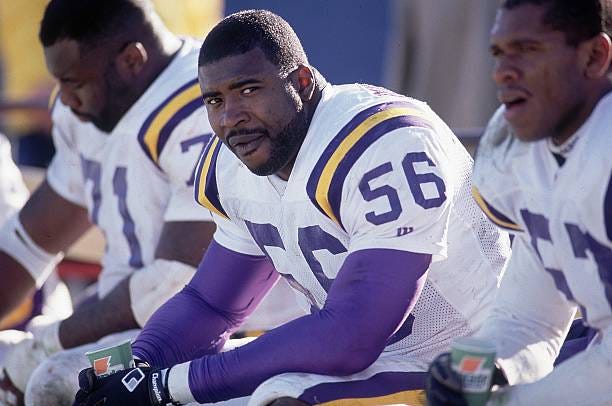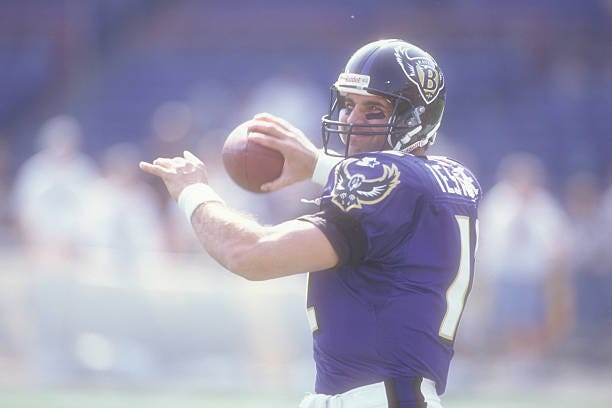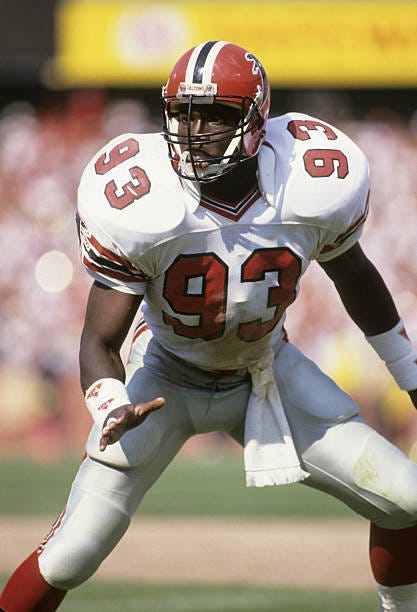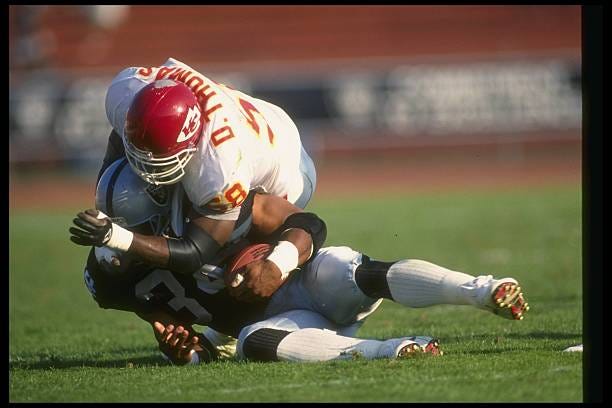Boom, Bust or ‘Tweener: Looking back at top NFL Draft picks in the 1980s, Part 2, 1985-89
Note: This is the second part of a series looking back at the top ten selections in each draft through the decade. Check out part one here.
1985
While the 1984 NFL Draft was almost a wasteland for producing future stars, the top ten selections in ’85 was a very impressive group.
Booms: Bruce Smith, DE, Bills, Chris Doleman, DE, Vikings, Lomas Brown, T, Lions. ‘Tweeners: Bill Fralic, G, Falcons, Ray Childress, DT, Oilers, Duane Bickett, LB, Colts, Ken Ruettgers, T, Packers, Ron Holmes, DE, Bucs, Al Toon, WR, Jets. Busts: Kevin Allen, T, Eagles
Smith headlines a talented group of defensive linemen. He started all 18 years of his Hall of Fame career and became one of the most feared pass rushers in NFL history. Smith went to 11 Pro Bowls and was an eight-time All-Pro. Smith played in 279 games, collecting an NFL record 200 sacks and 43 forced fumbles. Smith was voted Associated Press Defensive Player of the Year twice, in 1990 and ’96. He had 13 seasons of double-digit sack totals.
Doleman carved out his own niche as a dominant pass rusher. In 232 games with the Vikings, Falcons and 49ers, Doleman had 150.5 sacks and 44 forced fumbles. The Pittsburgh alum was an eight-time Pro Bowler and two-time All-Pro. He led the league with 21 sacks in 1989 and produced double-digits sack totals for eight seasons.
Brown was the anchor of the Lions’ offensive line for a decade. The 282-pound tackle protected a long list of Detroit quarterbacks and paved lanes for superstar running back Barry Sanders. Brown made only one All-Pro list but went to the Pro Bowl seven times. The Lions let Brown walk following the ’95 season, but he played seven more seasons with four teams, winning a Super Bowl with the Bucs in 2002. Brown started 251 of 263 games in his career. He isn’t in the Hall of Fame yet but has a solid resume to get there.
With the exception of Allen, the ’85 draft featured several good offensive linemen. Similar to Brown, Fralic, a two-time All-Pro and four-time Pro Bowler, could get the call to Canton. Fralic played nine seasons, starting 131 of 132 games.
Childress, a 6-foot-6, 272-pound defensive lineman, produced several outstanding seasons for the Oilers. Childress was selected to one All-Pro team and five Pro Bowls. He started 160 of 163 games, collecting 76.5 sacks and 887 combined tackles.
Bickett played 12 seasons for three teams, but two seasons really stand out. After a 141-tackle, six-sack season in ’85, he was named AP Defensive Rookie of the Year. In ’87, Bickett made his lone Pro Bowl selection with eight sacks and 113 combined tackles.
Ruettgers, a mainstay along the Packers’ offensive line for 12 seasons, surprisingly never made a Pro Bowl. The USC alum played in 156 games. Ruettgers made only one start in ’96 before getting injured but earned a Super Bowl ring.
Holmes played eight seasons, splitting time with Tampa Bay and Denver. He started 76 of 106 total games so it’s difficult to label him a bust. However, Holmes had just 36.5 sacks, 19 in four seasons with the Bucs.
The University of Wisconsin didn’t have stellar teams in the ‘80s, but somehow had three players taken in the first round in ’85. Toon joined Richard Johnson (11th, Oilers) and Darryl Sims (20th, Steelers) as Badgers picked in the first round. Toon played all eight seasons with the Jets, earning three Pro Bowl nods and one All-Pro selection. He had a league-leading 93 receptions in ’88 and finished with 517 for his career, along with 31 touchdowns.
Allen is the only bona true bust in the ’85 group. He played just one season, starting four games. Allen has one of the lowest production values of any of the top ten picks in the ‘80s.
1986
Booms: Leslie O’Neal, DE, Chargers. ‘Tweeners: Bo Jackson, RB, *Bucs, Tony Casillas, DT, Falcons, Jim Everett, QB, *Oilers, Jon Hand, DE, Colts, Jim Dombrowski, G, Saints, Keith Byars, RB, Eagles. Busts: Anthony Bell, LB, Cardinals, Brian Jozwiak, G, Chiefs, John Rienstra, G, Steelers.
Overall, the top ten in ’86 rates fairly high, but has no slam-dunk Hall of Famers. O’Neal has a very good shot of making it to Canton. O’Neal, a six-time Pro Bowler, was named AP Defensive Rookie of the Year in ’86. He had 132.5 sacks in 196 games. O’Neal had eight double-digit sack seasons.
For Jackson, one has to consider what might have been. He was the first pick in the draft, but declined to play for the hapless Bucs, choosing baseball. Jackson re-entered the draft in ’87 and was selected by the Raiders. He made his lone Pro Bowl appearance in ’90 before a devastating hip injury ended his career. Due to his baseball obligation with the Royals, Jackson never played a full season in the NFL. Check out my interview with Jackson biographer Jeff Pearlman here.
Casillas, a two-time Super Bowl champ with Dallas, played 12 seasons. He had 768 combined tackles with more than 100 stops three times. Casillas never made a Pro Bowl but enjoyed a lengthy, satisfying career.
Everett played 12 seasons for three teams, earning one Pro Bowl trip in ’90. With the Rams, Everett led the league in touchdown passes in ’88 (31) and ’89 (29). He finished with 203 TD passes and almost 35,000 yards passing. Everett also threw 175 interceptions.
Hand, a huge (6-7, 300 pounds) defensive end, played his entire nine-year career with the Colts. He started 110 of 121 games, totaling 35.5 sacks. In ’89, Hand had 10 sacks.
Dombrowski played 11 seasons, all in New Orleans. He started 137 of 151 games. The Virginia alum played both left guard and left tackle for the Saints, was durable, but never reached Pro Bowl status.
Byars only went to one Pro Bowl but was a valuable backfield contributor for four teams. Byars played 14 seasons and went to 13 playoff games. With 610 career receptions, Byars finished with more receiving TDs (31) than rushing (23).
Bell played in 102 games over six seasons but made just 65 starts. Career totals include 11 sacks and two interceptions.
Rienstra started only 48 games in seven seasons. His only season starting all 16 games was 1991 with the Browns. Reinstra retired in ’92 at age 29.
The Chiefs didn’t get much from Jozwiak. He played in 28 games through three seasons, never starting through a full season. After ’88, he was out of the league at age 25.
1987
Booms: Rod Woodson, DB, Steelers, Jerome Brown, DT, Eagles. ‘Tweeners: Vinny Testaverde, QB, Bucs, Cornelius Bennett, LB, Colts, Brent Fullwood, RB, Packers, Shane Conlan, LB, Bills. Busts: Alonzo Highsmith, RB, Oilers, Mike Junkin, LB, Browns, Kelly Stouffer, QB, Cardinals, Reggie Rogers, DE, Lions.
Along with Ronnie Lott (’81) and Deion Sanders (’89), Woodson is among the best defensive backs drafted in the ‘80s. He went to 11 Pro Bowls and was a six-time All-Pro selection. Woodson was the ’93 AP Defensive Player of the Year and won a Super Bowl with the Ravens. In 238 games, “Woody” had 71 interceptions. Woodson led the league twice, with seven picks in ’99 and eight in ’02 as a 37-year-old with the Raiders. In ’92, with the Steelers, Woodson had six sacks from his cornerback position.
Brown, a feared interior lineman on a great Eagles defense, was killed in a car accident in ’92. He was 27. Brown was a two-time All-Pro selection. He played in 76 games and had 29.5 sacks, posting 10.5 in ’89. Could Brown have been a Hall of Famer? Unfortunately, we will never know.
Testaverde, known for his longevity, played in two Pro Bowls. The Miami alum played 21 seasons for seven teams, retiring at age 44 with the Panthers. Testaverde threw 275 career TDs and 267 interceptions. In a two-year span with Tampa Bay, he totaled 57 interceptions, leading the league both times. Testaverde led the league two more times in interceptions, but also had 46,233 yards passing.
Bennett was traded to the Bills and became a defensive force. As a five-time Pro Bowler and one-time All-Pro, he could make a case for Canton. He played in 206 games with three teams, totaling 71.5 sacks and 31 forced fumbles. While he didn’t return to a Pro Bowl after age 28, Bennett played full seasons after age 32 with the Falcons and Colts.
Fullwood, if not for one Pro Bowl season, could be considered a bust. In ’89 he had 821 yards rushing and five TDs as a fullback with Green Bay. Fullwood ended his short career with the Browns following the ’90 season.
Conlon produced from the start, earning ’87 AP Defensive Player of the Year honors. The linebacker went to three consecutive Pro Bowls with the Bills. Conlon finished with more than 100 tackles three times, including 122 in ’91.
Highsmith, a large, physical back from Miami, never rushed for more than 531 yards in a season. He finished a disappointing career with 283 carries and seven TDs. Highsmith retired in ’92 at age 27.
Mike Junkin, not to be confused with brother Trey Junkin, played a total of 20 games. The inside linebacker started seven times between the Browns and Chiefs, retiring in ’89. In comparison, older brother Trey, drafted in the fourth round in ’83, played 261 more games than Mike. After a 20-year career, Trey retired in ’02 with the Giants.
Stouffer, one of the most notable QB busts of the ‘80s, never started a full season, retiring in ’92. The Colorado State star was traded to the Seahawks, to give starter Dave Krieg some competition. In 22 games, Stouffer finished 5-11 with seven touchdowns and 19 interceptions.
Rogers played in 15 games, starting only twice. He had two career sacks. Rogers was more known for his off-the-field problems. Emotional struggles halted his rookie season and in ’88, he was charged with vehicular homicide after allegedly killing three teenagers in a car crash. Rogers was reported to be legally drunk during the crash and spent 13 months in prison. He resumed his career in ’91 with the Bills, but after one season with the Bucs in ’92, was out of the NFL. Rogers’ problems with drugs continued following his football days. He died in 2013 at age 49 from a toxic mix of cocaine and alcohol.
1988
Booms: Neil Smith, DE, Chiefs, Tim Brown, WR, Raiders, Sterling Sharpe, WR, Packers. ‘Tweeners: Bennie Blades, DB, Lions, Paul Gruber, T, Bucs, Terry McDaniel, DB, Raiders, Eric Moore, G, Giants. Busts: Aundray Bruce, LB, Falcons, Rickey Dixon, DB, Bengals, Dave Cadigan, G, Jets.
To think the Falcons could have picked Smith at No. 1. Smith, out of Nebraska, forged a stellar career with the Chiefs, Broncos and Chargers, earning six Pro Bowl selections and one All-Pro nod. After nine seasons with K.C., Smith went to Denver and won two Super Bowls. He had 104.5 sacks in 191 games, including a league-leading 15 in ’93. The ball-hawking Smith also forced 30 fumbles. Smith hasn’t received a call to Canton yet, but his changes are favorable.
Brown never earned All-Pro status, but went to the Pro Bowl nine times. The Notre Dame legend hauled in 1,094 receptions for 14,934 yards and 100 touchdowns. His 104 receptions lead the NFL in ’97. After 16 excellent seasons with the Raiders, Brown played one season with the Bucs in 2004 before calling it a career. And what a career it was. In 2015, Brown entered the Hall of Fame.
Sharpe was on his way to Canton before a neck injury ended his career in ’94. The Packers missed on several high picks in the ‘80s, but hit the money on Sharpe. In seven seasons, the former Gamecock was selected to three All-Pro teams and made five Pro Bowl trips. Sharpe led the league in receptions three seasons. He followed a 108-catch season in ’92 with 112 in ’93. In ’92, bolstered by Brett Favre’s rocket arm and gutsy downfield throws, Sharpe led the league in receptions, yards (1,461), touchdowns (13) and yards per game (91.3). Tough, durable and confident, Sharpe never missed a game in seven seasons.
Blades made one Pro Bowl appearance with the Lions in ’91. Playing mostly safety, Blades had 14 interceptions in 10 seasons. He had 860 combined tackles in 136 games. For being the third overall pick, the former Miami Hurricane had an average career.
Despite not making a Pro Bowl, Gruber enjoyed a respectable career with the Bucs. In 12 seasons, the dependable 6-5, 292-pound left tackle played in 183 games. The Wisconsin native was named to the ’88 All-Rookie Team.
McDaniel turned in a standout 11-year career, earning five Pro Bowl trips. The Tennessee alum swiped 35 interceptions in 152 games, returning six for TDs. In ’94, McDaniel had seven interceptions, two touchdowns and 61 combined tackles.
Moore bounced around with four teams in eight seasons, starting 74 of 84 games. Moore played in seven playoff games, winning a Super Bowl with the Giants in ’90. His career highlight was three fumble recoveries in ’89. Moore started all 16 games just once, in ’91.
If Bruce would have been selected in the fourth or fifth round, his career would be considered decent. But the 6-5, 265-pound outside linebacker was the top pick in ’88. His numbers didn’t live up to his high billing. In 11 seasons with the Falcons and Raiders, Bruce started 41 of 151 games, producing 32 sacks. He never posted more than six sacks in a season, and only started all 16 games once, his rookie campaign in ’88. After playing one game with the Raiders in ’98, Bruce retired.
Dixon had six lackluster seasons, starting only 32 games. After a dismal rookie season, Dixon started all 16 games and picked off three passes in ’89. After ’89, however, he never started more than nine games in a season. The Bengals gave up on him after five seasons. Dixon played in nine games for the Raiders in ’93 before retiring.
Cadigan missed 18 games in seven seasons and never lived up to his draft status. The Jets kept the former USC lineman through the ’93 season before cutting him loose. Cadigan played in 13 games for the Bengals in ’94 and called it a career.
Note: Michael Irvin, “The Playmaker,” was selected 11th overall by the Cowboys. With Brown and Sharpe, the first 11 selections produced three potential Hall of Fame wide receivers.
1989
Booms: Troy Aikman, QB, Cowboys, Barry Sanders, RB, Lions, Derrick Thomas, LB, Chiefs, Deion Sanders, DB, Falcons. ‘Tweeners: Eric Hill, LB, Cardinals, Broderick Thomas, LB, Bucs, Burt Grossman, DE, Chargers. Busts: Tony Mandarich, T, Packers, Tim Worley, RB, Steelers, Sammie Smith, RB, Dolphins.
The top ten in ’89 yielded interesting results. Four players are in the Hall of Fame, while five others are considered busts. Looking back three decades later, teams with a top-five pick had a golden opportunity to get a franchise-altering performer. Well, unless you’re the Packers.
Aikman was a six-time Pro Bowler and led the Cowboys to three championships. He finished his 12-year career 165 touchdown passes and 141 interceptions. Aikman racked up nearly 33,000 yards through the air. After back-to-back seasons with 18 interceptions, Aikman turned his fortunes around in ’91. He led the NFL with a 69.1 completion percentage in ’93 and tossed only seven interceptions in ’95. Aikman’s numbers aren’t as impressive as Marino, Elway and Kelly, but he proved to be the steady leader Dallas needed to orchestrate its dynasty.
Sanders, a compact 5-8, 203 pounds, hit the ground running in Detroit. The Kansas native made the Pro Bowl every season of his 10-year career, earning All-Pro honors six times. Sanders led the league in rushing four times, eclipsing 2,000 yards in ’97. Sanders shared the Most Valuable Player award with Favre in ’97 and was named AP Offensive Player of the Year three times. In 153 games, the Oklahoma State alum rushed for 15,269 yards, scored 99 touchdowns and led the league in yards per game for three seasons. On the cusp of breaking Walter Payton’s all-time rushing record, Sanders abruptly retired in the summer of ’99.
Thomas made the most of his career before it was tragically cut short following the ’99 season. Thomas made nine Pro Bowls and was twice selected All-Pro. He was the ’89 Defensive Rookie of the Year, but he was just getting started. In ’90, Thomas led the NFL with 20 sacks and six forced fumbles. Thomas finished his career with 41 forced fumbles and 126.5 sacks. In 2000, Thomas died from injuries sustained in a car accident. He was 33. Thomas was elected to the Hall of Fame in 2009.
A year after whiffing on top pick Aundray Bruce, the Falcons got it right. Deion Sanders only spent five seasons in Atlanta, but made the Pro Bowl three times and twice was named All-Pro. After leaving the Falcons, Sanders helped the 49ers to a Super Bowl title and was named Defensive Player of the Year. Sanders went on to play for the Cowboys, winning another title, along with the Redskins and Ravens. He finished with 53 interceptions, returning nine for touchdowns. “Prime Time” also caught 60 passes and scored three TDs as a receiver.
Hill played 160 games through 11 seasons but never reached a Pro Bowl. A versatile linebacker, Hill finished with 1,043 combined tackles, with more than 100 five times. After leaving the Cardinals following the ’97 season, the former LSU Tiger played two more seasons, splitting time with the Rams and Chargers.
Thomas proved to be a steady linebacker in nine seasons with the Bucs, Lions, Vikings and Cowboys. He notched a league-leading seven forced fumbles in ’91, along with 11 sacks. But Thomas exceeded the 100-tackle threshold only twice and was on the decline by the time he reached Dallas in ’96.
Following back-to-back 10-sack seasons in ’89 and ’90, Grossman’s production dipped. After five seasons with the Chargers, Grossman played one year with the Eagles and retired. He finished with 43.5 sacks in 86 games.
Mandarich, a hulking 6-5, 311-pound tackle, was a bona fide beast at Michigan State. It was not surprising the Packers, coming off a miserable ’88 season, picked Mandarich second overall, hoping “Tony the Terrible” would anchor the offensive line well into the ‘90s. After not starting a game his rookie season, Mandarich started 31 of 32 games in ’90 and ’91. But his career flamed out and he was out of football by ’92. Getting over past addictions, which included steroid abuse, Mandarich returned to football in ’96, and logged three seasons with the Colts.
Steeler Nation is still befuddled over Worley. The seventh overall pick showed promise his rookie season with 770 yards rushing and five touchdowns, but it was downhill from there. Worley missed the entire ’92 season with a substance abuse violation and was sent packing. After resurfacing with the Bears in ’93, Worley got another shot with Pittsburgh late in the season but played only five games. After nine carries and 17 yards rushing for the Bears in ’94, Worley retired.
The Dolphins selected Smith hoping the running back would complement QB Dan Marino in the backfield. The rushing attack never materialized. In 41 games in Miami, Smith rushed 532 times for 1,881 yards and 15 TDs. The Florida State alum showed flashes of promise. Smith posted 831 yards and eight TDs in ’90 but couldn’t match that output. After one season with the Broncos in ’92, Smith was out of the league.







